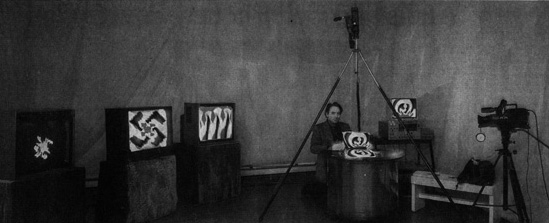 |
 |
 |
 |
 |
 |
 |
 |
 |
 |

The Videograph is a prepared video instrument designed to process images in real time for a performance venu. The videograph was invented and built by William Laziza. It is named after another invention that changed the 20th Century, the phonograph because it uses a turntable to create the graphic images. The Videograph provides the ability for images to be regenerated with angular offsets that work together to produce complex moving designs. The system has X, Y, Z and 360 degrees of rotational flexibility. It is coupled to a digital mixer, keyer, colorizer that is used to modulate the images. The system is interconnected with multiple loops that allow numerous patching possibilities between the videograph main, videograph processed, camera and external feed. The Vidician (operator of the Videograph similar to Musician) is able to operate the videograph and the switches so that moving real time image regenerations are formed live along with original images and music. The videograph was unveiled at the Micro Museum on December 10, 1999 and was used in performaces during the opening. Mr. Steve Hart of The New York Times photographed the Videograph for an article entitled "The Artist Formerly Known as Spectator" by Ann Powers which appeared in "The Milennium" a special section on the Future which came out January 1, 2000. The photo is titled "The Future is now: William Laziza with his "Videograph" installation at the Micro Museum in Brooklyn. The Piece lets visitors create television images reflecting the trend topwards interactive art." This image has been enhanced because the TV images originally published were washed out, click on the photo for a larger view of The New York Times page and photograph.
 |
 |
